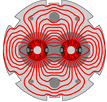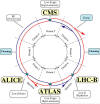-
The LHC is installed in a tunnel 3.8 m. in diameter,
buried 50 to 175 m. below ground. The tunnel straddles the French-Swiss
border to the North-West of Geneva. [see map above]
-
Two counter rotating beams are
injected into the LHC from the SPS accelerator (the Super Proton
Synchrotron).
-
The proton beams are injected at 450 GeV and then accelerated
to 7 TeV.
-
The beam moves around the LHC ring inside a continuous vacuum chambers
which pass through a large number of magnets.
-
1232 dipole magnets bend the beam around the 27 km.
ring. The momentum of the beam is very high and these magnets have
to produce a very strong magnetic field.
-
To reach the high magnetic field required, high currents
are needed. To avoid excessive resistive losses, the magnets are
superconducting. A huge cryogenics system
is required to produce the liquid helium needed to keep the magnets
cold.
-
The cables of the
magnets are of a very special design and conduct current without
resistance in their superconducting state
-
The beams will be stored at high energy for 10 to 20
hours (with a bit of luck). In 10 hours the particles make four hundred
million revolutions around the machine. During this time collisions take
place inside the four main LHC EXPERIMENTS.



